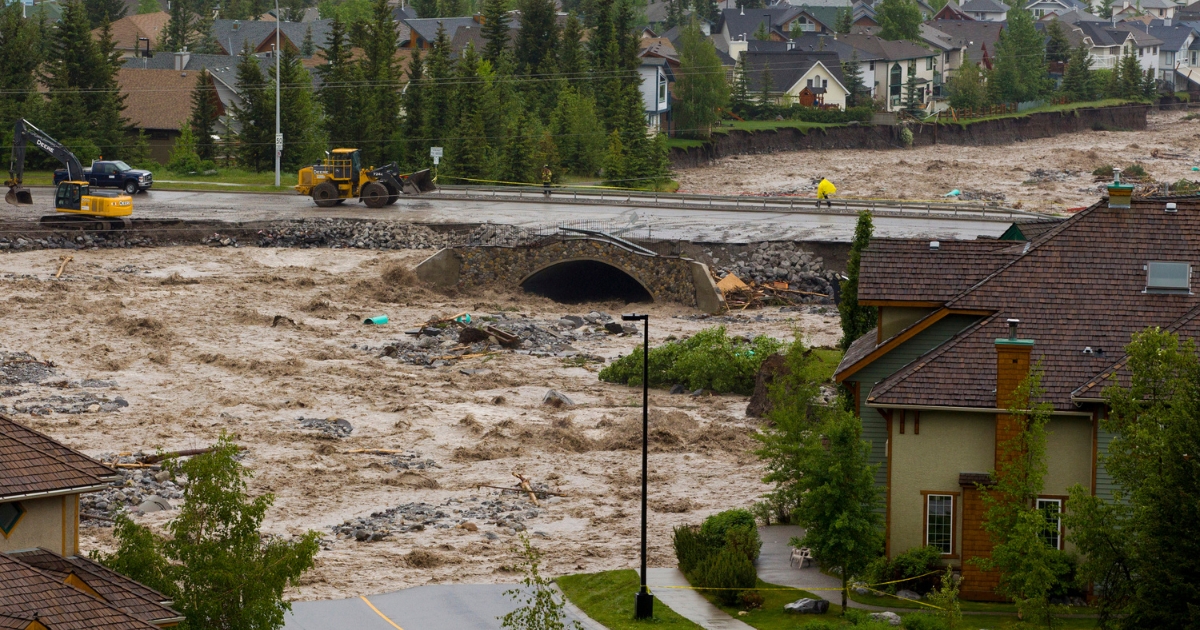Rebecca Innes Consulting
Case Study
Town of Canmore
Rebecca Innes Consulting
Case Study
Town of Canmore
Case Study Interviewee
Caitlin has been working in public sector operations for over 20 years and has been with the Town of Canmore (TOC) since 2022. At TOC, she oversees municipal law enforcement, RCMP contracts, and the Town’s traffic enforcement contract. Under the Emergency Management Act, she’s also responsible for overseeing and coordinating all emergency management and preparedness initiatives in Canmore.

Caitlin Miller, Protective Services Manager and Director of Emergency Management, Town of Canmore
Key Outcomes
- 16,000+ community members are supported by the Disaster Recovery Framework RIC created for the Town of Canmore.
- RIC saved the Town of Canmore over 70+ hours developing the framework, providing specific expertise the team didn’t have and reducing the lift for their overburdened team.
- The framework provides greater safety and security with a structured process that provides visibility into previously unknown factors and areas where action should be taken.
- RIC’s framework facilitates communication with potential aid and funding providers, enabling the Town of Canmore to make a strong case for funding.

Strengthening Community Disaster Preparedness
After a challenging fire season across Canada in 2023, the Town of Canmore (TOC) team realized they needed a more comprehensive disaster preparedness plan. They were looking to develop a plan that would help them get ready for the re-entry and recovery process in the wake of disaster, and provide a clear path forward for all parties responsible for disaster recovery.
Navigating Time and Resource Constraints
TOC has a small team with limited resources working to support a growing community, including a fluctuating population of temporary residents and tourists. The team didn’t have the bandwidth to complete an audit of their preparedness strategies and build a framework to support their community’s unique needs.
A Complete, Custom Disaster Recovery Framework
Rebecca Innes Consulting (RIC) took the work of putting together a comprehensive Disaster Recovery Framework off of the TOC team’s desks. With expertise in recovery planning best-practices as well as deep local knowledge, RIC provided the Town with a done-for-them framework that will empower everyone involved in emergency management in Canmore.
“Our small team does most emergency management work off the sides of our desks. With RIC, we were able to complete the Disaster Recovery Framework project quickly and efficiently. Rebecca looked at our preparedness planning comprehensively, combining her expertise in best-practices with her local knowledge of Canmore.”
The Town of Canmore is responsible for the governance and municipal services provided to nearly 16,000 residents. In addition to its population of permanent residents, Canmore—which is nestled in the Canadian Rockies just an hour west of Calgary—also welcomes many tourists and temporary visitors. Around 26 percent of private properties belong to occasional residents.
TOC has a small team responsible for ensuring that municipal services meet the needs of both full-time residents and visitors, especially during peak tourist season in the summer. This is also when the region is more vulnerable to wildfires and floods. Major transport routes including the railway and the Trans-Canada Highway run through Canmore, which means the community is at risk of disasters like hazardous chemical spills as well.
Disasters are affecting Canadian communities more and more frequently. As the Protective Services Manager and Director of Emergency Management for TOC, Caitlin Miller makes a point to learn from the ways other municipalities have struggled to make a strong recovery.
“A lot of lessons came out of the challenges Yellowknife encountered in the reentry process after the wildfires in 2023,” Caitlin says. “The learnings gave me a sense of urgency around ensuring that Canmore would be able to get ahead of those types of challenges if something similar happened to us.”

Limited Internal Bandwidth for Improving Emergency Preparedness
While the municipality is the local authority during disasters, they have limited resources to deliver comprehensive aid and recovery services to residents and visitors in the event of an emergency.
The bulk of the emergency management and preparedness work at the Town of Canmore is done off the side of team members’ desks, due to multiple priorities. Canmore also has a small tax base—which means lower municipal funding—and a high need in terms of disaster preparedness.
The challenges in the Northwest Territories illuminated pressing concerns for Caitlin and her team, which included questions like:
- Who should get priority in the re-entry process?
- What supports need to be in place when people return to the community?
- Who is responsible for all the different aspects of recovery?
- Who can we call on to fill those roles?
- How do we minimize delays and start recovery sooner?
“It’s hard to know how to return if you don’t have the process or priorities set up ahead of time,” says Caitlin. “I knew we needed to have the right people in place to address those priorities and to understand how they would work together. I realized that I didn’t know who I had around the table to manage re-entry and recovery.”
The TOC team felt that without greater structure to their disaster recovery plan, critical aspects of recovery would be missed and their small team would struggle to support the community.

The Right Connection at the Right Time
Caitlin didn’t have to search for the right consultant to support her team. Rebecca Innes, Founder of Rebecca Innes Consulting (RIC), regularly connects with municipalities and other emergency management professionals to build relationships and offer support. She reached out to Caitlin directly to check in as a fellow local working in the emergency management sector.
Caitlin brought up that her team was looking to improve their disaster recovery planning and Rebecca let her know that RIC could provide a customized Disaster Recovery Framework to meet their needs. Since Caitlin had previously discussed RIC’s services with Rebecca Innes, they were top of mind when the project came up.
“The RIC team clearly laid out the timelines for the project and outlined exactly what materials or work they would need from me throughout the process right from the kickoff meeting,” Caitlin says. “Communication was great throughout. Rebecca checked in regularly and was flexible with scheduling meetings.”

A Comprehensive Framework to Lean on During Disasters
RIC prepared a comprehensive Disaster Recovery Framework for the Town of Canmore that will enable the emergency management team to collaborate and execute on the steps necessary for successful re-entry, recovery, and long-term resilience. With this work off of Caitlin’s desk, she and her team were able to focus on other initiatives and their everyday work supporting Canmore residents.
The framework serves as a single source of truth for Caitlin’s team and all the individuals and organizations that will have a role in the recovery process.
Key highlights of the framework:
- Clearly lays out the goals for recovery and the principles driving those goals.
- Provides structure for each of the three phases of recovery (short-, medium-, and long-term), and which activities happen during each phase.
- Establishes roles and responsibilities across departments and sectors in the Canmore community (known as the Recovery Coordination Centre).
- Provides a decision-making structure for the Recovery Coordination Centre.
- Customized based on what’s most important to Canmore residents, and accommodates the community’s unique social and cultural needs.

To create the framework, the RIC team combined their local knowledge of Canmore and their expertise in disaster recovery best-practices, delivering a document that TOC can follow in the event of a variety of potential emergencies. The framework provides much-needed structure for those who will be responsible for overseeing recovery, but it’s also flexible enough to be used in many disaster scenarios.
“Rebecca identified the gaps between what the community actually needs versus what the provincial government suggests,” says Caitlin. “She gave us a product that fit within our current program.”
RIC provided insights and planning around the socio-cultural needs in the community, shedding light on previously unknown factors that could be impacted by disaster. The team also prioritized the aspects of recovery that intersect with Truth and Reconciliation to ensure that the specific needs of the Indigenous communities in the Canmore area, including the Stoney Nakoda, Blackfoot, Tsuut’ina nations, and the Rocky View Metis District 4 within the Battle River Territory will be addressed in the wake of disaster.
RIC created a product that Caitlin sees the Town using for years to come, saving time and reducing stress during future recovery processes.
“The whole team has confidence in using the framework moving forward,” Caitlin says. “It was a relief to have this initiative off our plates and we feel more prepared to manage emergencies in the future.”

Creating a Disaster-Resilient Bow Valley Community
The Town of Canmore will use the Disaster Recovery Framework to guide the community through re-entry and recovery in the wake of future disasters. TOC’s next initiative is increasing interoperability between other groups and municipalities in the region to strengthen response and recovery capacity. As the Town connects with other leaders, the framework and knowledge provided by RIC will have a lasting impact on the resilience of the community overall.
Curious to learn more?
Contact Rebecca Innes Consulting (RIC) to learn more about our emergency and disaster management solution services.
RIC BLOGS
Five Keys to Securing Disaster Financial Assistance
Securing funding for disaster recovery can be a challenge for small emergency management teams, especially those in Indigenous communities. In addition to identifying funding options, teams are often faced with bureaucracy and a heavy administrative burden as they...
What Now? Mastering Your Community’s Disaster Recovery Plan
Disasters have a deep, lasting impact on individuals and their communities. An effective plan that incorporates all components of disaster recovery considers the weeks, months, and years after the initial emergency has occurred. Disasters damage infrastructure and...











